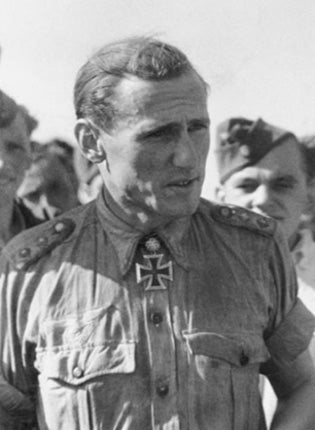General Günther Rall: Luftwaffe fighter ace who helped create the modern German airforce

Günther Rall, a seasoned German fighter ace who was still only 23 years old, was told he would not walk again, yet he defied medical opinion to become one of the leading pilots of the Second World War and made an important contribution to developing the post-war German air force.
Rall was born on 10 March 1918, in Gaggenau, a small village in the Black Forest. His father was a company secretary who had served in the First World War and later joined the nationalist ex-soldiers' Stahlhelm [steel helmet] organisation. When Günther was three the family moved to Stuttgart and he was educated there in elementary school and later, for nine years, in the Karls-Gymnasium (a grammar school), where the emphasis was on Latin and ancient Greek rather than on science or mathematics.
After matriculating with his university-entrance Abitur in 1936, and doing a year of compulsory labour service, he volunteered as an officer cadet in an infantry regiment. Perhaps seduced by the glamour of the rapidly expanding air force, Luftwaffe, he transferred to the air arm in 1938, graduating as lieutenant the following year.
He recalled that there was no enthusiasm for war in September 1939. His first experience of combat was as a fighter pilot in May 1940 during the Blitzkrieg offensive in France. After the fall of France, he saw action against the RAF over the Channel and southern England, where his squadron's losses against the Spitfires and Hurricanes were heavy.
When the Battle of Britain ended, Rall was moved to Romania and then saw action in Crete. From the invasion of the Soviet Union in June 1941 until 1944 he flew sorties in southern Russia, including Stalingrad. In November 1941 he was shot down between Taganrog and Rostov, seriously injuring his back and remaining in hospital until July 1942. He was advised that he would not walk again but he beat the odds and returned to flying.
This was only the first such incident: in all he was injured four times. Not surprisingly he was seen in the German newsreels and was personally decorated by Hitler four times for his 275 "kills". He later claimed that his illusions were destroyed the first time he met Hitler, in 1942. In the spring of 1944 he was posted back to Germany to assist in the defence of the Reich, flying against the US Eighth Air Force, whose aircraft he felt were superior to the planes he flew, the Messerschmitt Bf-109 and its variants, and the Focke-Wulf Fw-190.
It was in hospital in Vienna that he met his future wife, Hertha Schön, the doctor in charge of his case. They married in 1943. His marriage was to bring him to the attention of the Gestapo because his wife had helped Jews to leave Vienna after the Nazi takeover in 1938. He was briefly interrogated about this at the front in 1943.
Rising to major and commanding fighter groups and entire squadrons, Rall survived the War as the third-highest-scoring fighter ace of all time with his 275 kills. He felt lucky to be captured by the Americans in 1945. In captivity he first heard of Auschwitz and, to begin with, although they had heard of Dachau concentration camp, he and his comrades thought Auschwitz was just propaganda. Later they became convinced of the truth. "The extermination of the Jews was the greatest madness of what was in any case a mad war," he concluded. Rall was interrogated by the Americans in Germany, and then by the British at RAF Tangmere, where he met some of his former opponents, with whom he later became friends.
In the early post-war years his wife pursued her medical career while Rall started a small woodcutting business, as well as becoming a teacher and administrator at the boarding school at Salem. He also worked as a representative for Siemens, leaving in 1953.
In July 1955 the West German parliament agreed to set up the new armed force, the Bundeswehr, though Rall was not among the 150,000 volunteers who were sworn in. But after calls from his old Luftwaffe friends he volunteered. In January 1956 he was called to Bonn and joined the new air force as major. He underwent refresher training, first in Germany, and later at Luke Air Force Base, Arizona, where he trained on the Republic F-84 (Thunderjet). Between 1971 and 1974 Rall served as head of the West German air force, and then spent a year as German representative on the Nato Military Committee in Brussels.
His retirement came suddenly; he went on a three-week private visit to South Africa, where he held conversations with South African politicians about which his minister claimed to know nothing. The "private" nature of this visit was later hotly contested especially by the weekly magazine Stern. As South Africa, despite its racist regime, was seen as strategically important to Nato it seems likely that was commissioned to go. However, after a press campaign, the Defence Minister Georg Leber was forced to dismiss Rall in October 1975.
In retirement, Rall remained interested in aviation and world affairs, travelling abroad to aviation museums. In 2004 he published his memoirs, Mein Flugbuch: Erinnerungen 1938-2004 (My Flight Book: Memories, 1938-2004). Earlier this year he denounced the Iraq war and said he was glad that Germany was not involved in it.
David Childs
Günther Rall, pilot and head of Luftwaffe: born Gaggenau, Germany 10 March 1918; married 1943 Hertha Schön (died 1985; two daughters, and two children deceased); died Bad Reichenhall 4 October 2009.
Join our commenting forum
Join thought-provoking conversations, follow other Independent readers and see their replies
Comments
Bookmark popover
Removed from bookmarks